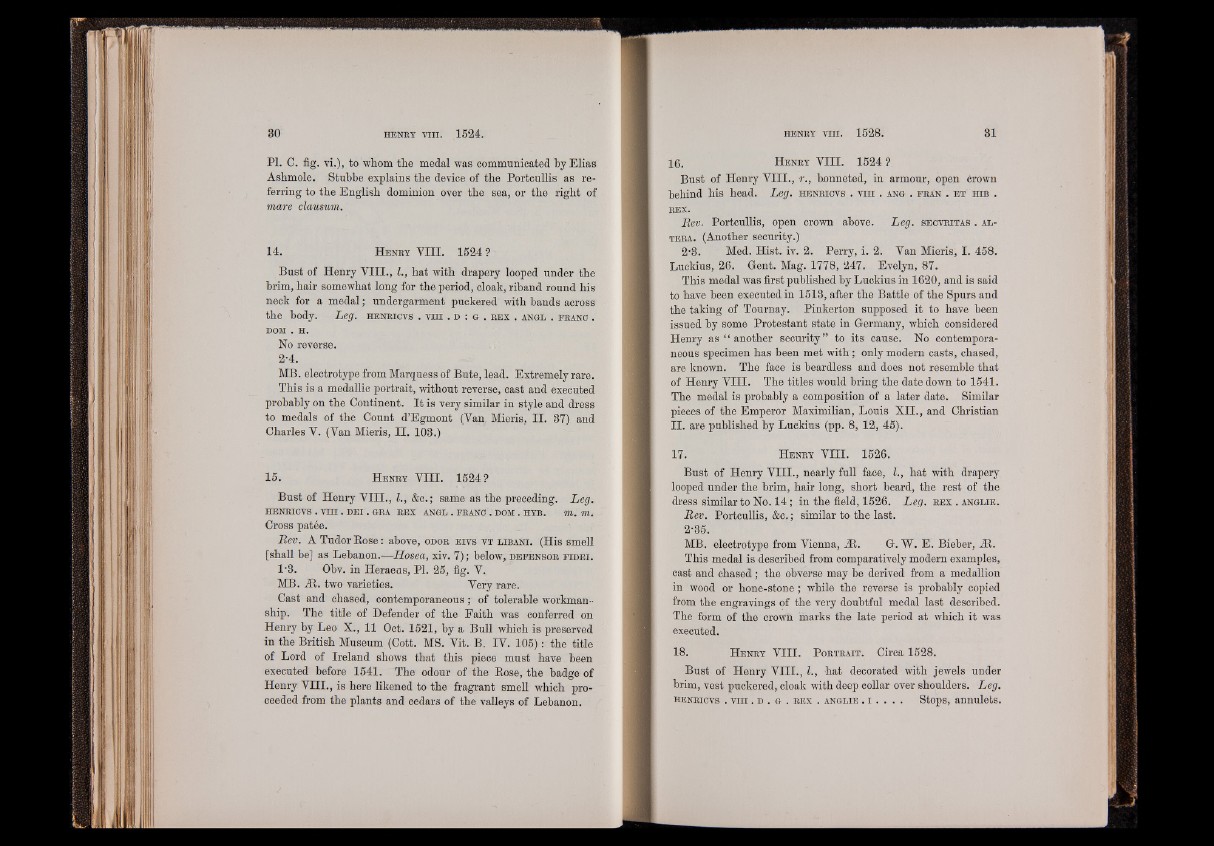
PI. C. fig. vi.), to whom the medal was communicated by Elias
Ashmole. Stubbe explains the device of the Portcullis as referring
to the English dominion over the sea, or the right of
mare clausum.
14. H enry YIII. 1524 ?
Bust of Henry YIII., I., hat with drapery looped under the
brim, hair somewhat long for the period, cloak, riband round his
neck for a medal; undergarment puckered with bands across
the body. Leg. h e n r i c v s . v h i . d : g . r e x . a n g l . f r a n c .
DOM . H.
No reverse.
2-4.
MB. electrotype from Marquess of Bute, lead. Extremely rare.
This is a medallic portrait, without reverse, east and executed
probably on the Continent. It is very similar in style and dress
to medals of the Count d’Egmont (Van, Mieris, II. 37) and
Charles Y. (Van Mieris, I I . 103.)
15. H e n r y Y i n . 1524?
Bust of Henry VIII., I., &c.; same as the preceding. Leg.
HENRICVS . V in . D E I . GRA REX ANGL . FRANC . DOM . HYB. TO. TO.
Cross pâtée.
Rev. A Tudor Bose : above, o d o r e i v s v t l i b a n i . (His smell
[shall be] as Lebanon . ^ 1 1osea, xiv. 7); below, d e f e n s o r f i d e i .
1'3. Obv. in Heraeas, PI. 25, fig. V.
MB. Æ. two varieties. Very rare.
Cast and chased, contemporaneous ; of tolerable workmanship.
The title of Defender of the Faith was conferred on
Henry by Leo X., 11 Oct. 1521, by a Bull which is preserved
in the British Museum (Cott. MS. Vit. B. IV. 105) : the title
of Lord of Ireland shows that this piece must have been
executed before 1541. The odour of the Rose, the badge of
Henry VHI., is here likened to the fragrant smell which proceeded
from the plants and cedars of the valleys of Lebanon.
16. H enry VIII. 1524 ?
Bust of Henry VIII., r., honneted, in armour, open crown
behind his head. Leg. h e n r i c v s . vin . a n g . f r a n . e t h i b .
REX.
Rev. Portcullis, open crown above. Leg. s e c v r i t a s . a l t
e r a . (Another security.)
2-3. Med. Hist. iv. 2. Perry, i. 2. Van Mieris, I. 458.
Luckius, 26. Gent. Mag. 1778, 247. Evelyn, 87.
This medal was first published by Luckius in 1620, and is said
to have been executed in 1513, after the Battle of the Spurs and
the taking of Toumay. Pinkerton supposed it to have been
issued by some Protestant state in Germany, which considered
Henry as “ another security ” to its cause. No contemporaneous
specimen has been met with; only modern casts, chased,
are known. The face is beardless and does not resemble that
of Henry VIII. The titles would bring the date down to 1541.
The medal is probably a composition of a later date. Similar
pieces of the Emperor Maximilian, Louis XII., and Christian
II. are published by Luckius (pp. 8, 12, 45).
17. H enry VHI. 1526.
Bust of Henry VIII., nearly full face, L, hat with drapery
looped under the brim, hair long, short beard, the rest of the
dress similar to No. 14; in the field, 1526. Leg. r e x . a n g l ie .
Rev. Portcullis, &c.; similar to the last.
2-35.
MB. electrotype from Vienna, JR. G. W. E. Bieber, JR.
This medal is described from comparatively modern examples,
cast and chased ; the obverse may be derived from a medallion
in wood or hone-stone; while the reverse is probably copied
from the engravings of the very doubtful medal last described.
The form of the crown marks the late period at which it was
executed.
18. H e n r y VIII. P o r t r a i t . Circa 1528.
Bust of Henry VIII., I., hat decorated with jewels under
brim, vest puckered, cloak with deep collar over shoulders. Leg.
h e n r i c v s . vm . d . g . r e x . a n g l i e . i . . . . Stops, annulets.